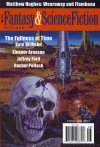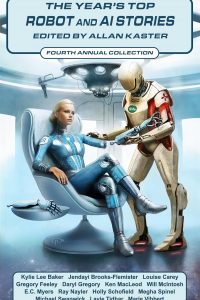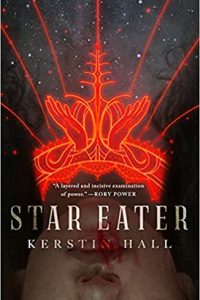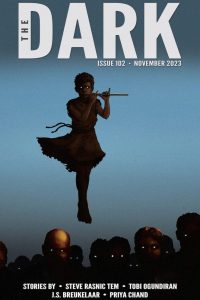Lois Tilton reviews Short Fiction, mid-June
The highlight this time is F&SF, with the best issue I’ve seen in almost a year. I give the Good Story award to the pieces from Wilhelm, Arnason and Ford.
Publications Reviewed
- F&SF, July/August 2012
- Arc 1.2, May 2012
- Lightspeed, June 2012
- Strange Horizons, June 2012
F&SF, July/August 2012
A superior issue. The editor tells us the stories are full of wizards, which is true, but a lot of the good stuff is wizard-free, most notably a fine novella by Kate Wilhelm and a short anthropological tale by Eleanor Arneson.
“The Fullness of Time” by Kate Wilhelm
Mercedes is a freelance researcher hired by a documentary producer to work on the late Hiram Granville, a reputed genius who got rich by inventing, patenting, and collecting royalties. His son is apparently just as brilliant in the field of investments. And just as reclusive.
“Cat,” I said, “listen up. The family lives on a great big estate, half of Pennsylvania big, and they don’t come out and don’t let outsiders in. They have seizures or something, maybe they stash the nuts away in their own hospital. They have their own landing pad and helicopter, and no one’s seen them in public since the Flood. There aren’t even any pictures of them available. Nada.”
But there’s something odd about their achievements. Old Hiram tended to patent his ideas just ahead of someone else who had already been working on them. And son John has several times been investigated for insider trading, based on the timing of his moves in the markets. It’s too good to be real, and timing, of course, is the operative word. SF readers will recognize what’s going on, but of course the devil, the story, is in the details that Mercedes and Cat slowly reveal.
Wilhelm is an accomplished mystery author, and this is the story of an investigation, detective work, uncovering a criminal conspiracy. Throughout, the shadow of danger follows the characters, as they are challenging people with vast wealth and the power it can buy, people whose secrets they are planning to expose. Tense and compelling.
–RECOMMENDED
“Wearaway and Flambeau” by Matthew Hughes
Raffalon’s profession was the transfer of valuables to his possession without consultation or consent of their owners. He’d been practicing it since boyhood and had become quite good at wall-scaling, lock-tickling, and ward-hoodwinking. He was particularly versed in the art of the rapid exit when circumstances turned adverse.
In short a thief, complete with Guild – a commonplace in fantasy fiction. This time, Raffalon has been nabbed in the act of breaking into the well-warded stronghold of the wizard Hurdevant the Stringent. The wizard employs an experimental punitive spell, which, fortunately for the thief, goes awry in a manner that offers unexpected possibilities.
Entertaining stuff. The editorial blurb claims that this one is set in the author’s far-future universe, but it seems like a typical fantasy world of the sort with wizards and thieves.
“The Afflicted” by Matthew Johnson
In essence, zombies, although the word isn’t used. It seems to afflict mainly the old, who have been quarantined in tent camps behind razor wire. Naturally, this doesn’t work. Kate is a rifle-toting nurse who makes a circuit of the camps, treating more ordinary ills.
Their affliction aside, my patients’ age and the conditions they lived in meant that each of them had a host of issues for me to deal with. I counted on Horace to keep an eye on who was seriously injured, who had developed anything infectious, and who was showing signs of going end-stage. Everything else — minor illnesses and injuries, the frequent combination of scurvy and obesity caused by their diet of packaged food — I couldn’t even hope to treat.
The zombie affliction serves as a metaphor – for dementia and possibly for AIDS. It echoes the constant outcries we hear today from politicians and their minions to confine the undesirables, however defined. It also illustrates the false mercy of such systems, that take meaningful life from their victims yet refuse to end the suffering of their existence, refuse to make the hard but necessary choices. Yet the story itself illustrates how entirely impractical this particular system is; the author has set it up to fail, so of course it does.
“Jack Shade in the Forest of Souls” by Rachel Pollack
Jack of many names is a Non-Linear Traveler who has taken a vow that he can’t refuse anyone who comes to him for help bearing his card, with a design that readers [OK, older readers] should find familiar:
“John Shade,” and below that, “Traveler,” then Hôtel de Rêve Noire, New York, and in the final line no words, only a silhouette of a chess piece, the horse-head knight in the classic design.
William Barlow says that he found the card among the possessions of his wife shortly after her death, when he began to hear a chorus of voices and finally saw a vision:
“Dense trees, with twisted branches and no leaves, going on as far as you could see. And flames. A kind of faint fire, so pale it didn’t give off any light or heat or even burn any of the trees.”
Jack recognizes the Forest of Souls as the place where Alice Barlow is trapped, and where he must go to find her. Or so he supposes.
A neat magical world of adepts*, archetypes and symbols. The story is interesting enough before it takes a faintly-foreshadowed twist. There is a backstory that plays a significant role, and the author makes the unusual choice to present it as an epilogue, or rather a prologue following the conclusion. I’m not sure that this works.
*One could call them wizards.
“Hartmut’s World” by Albert E Cowdrey
This issue’s Cowdrey presents another wizard. Morrie and Jimmie are paranormal investigators hired by Sam Ciaccio, a mobster from Jersey now developing a ski resort, who made the mistake of importing the haunted castle of warlock Graf Hartmut von Drachenfels from Transylvania. The locals are blaming Sam/the castle/Dracula for a series of disappearances in the area, and this isn’t going to do the resort business any good.
“When I hoid that story, guys, my fletch crawled. That’s all I can say — my fletch crawled. Sandra leaves them drinking our Starbucks at nine dollars a pound, comes home and announces she’s outta here. The West is too goddamn wild for her, she’s going back East. So here I’m left all alone, wife gone, daughter off somewhere saving abused chickens. And the people around here, they’re toining ugly.
Amusing if you like thickly-spread wiseguy clichés.
“The Woman Who Fooled Death Five Times” by Eleanor Arnason
A Hwarhath folktale from an author of whom we don’t see nearly enough. The narrative takes the form of an anthropologist’s report [complete with footnotes] on the subject of the Hwarhath use of the figure Death. It’s always charming to see the down-to-earth attitudes of this furbearing species.
In the end, the world was done and seemed more than adequate. As for the Goddess, she felt bloated and overfull. She made herself a medicinal tea and drank it. Then she had an enormous bowel movement.
After she had finished, she looked at the heap of dung. “Well, that looks nasty and smells nasty, too.”
The heap moved, and a voice came from it. “Don’t be too critical. I am a creation of yours, just as the world is.”
There are plenty of human tales about cheating Death, but this, too, has a unique slant. It’s hard to believe Arnason is not actually reporting from the Hwarhath world.
–RECOMMENDED
“The Natural History of Autumn” by Jeffrey Ford
Riku is attracted to Michi when he meets her in an upscale hostess bar. She tells him she is writing a book about autumn, and he offers to take her to a secluded country retreat owned by his wealthy mobster – and possibly wizardly – employer. The place seems idyllically perfect for their purpose.
After hours of winding along the rims of steep cliffs and bumping down tight dirt paths through the woods, the silver car pulled to a stop in a clearing, in front of a large, slightly sagging farmhouse — minka style, built of logs with a thatched roof. Twenty yards to the left of the place there was a sizeable garden filled with dying sunflowers, ten-foot stalks, their heads bowed. To the right of the house there was a slate path that led away into the pines. The golden late-afternoon light slanted down on the clearing, shadows beginning to form at the tree line.
Nice prose. It’s the sort of story that gives scant hints at first of the way it will end. But we certainly sense a strong taint of the sinister in the aged housekeeper’s nasty-looking dog, and it eventually reveals itself a tale of deceit and treachery. The jinmenken, a kind of supernatural dog from the rich mine of Japanese folklore, is used to good effect.
–RECOMMENDED
“Wizard” by Michaele Jordan
Rachel is on her way to class, presumably violin class, when she is attracted to a man. It’s not love, it’s a spell of some kind; she simply can’t walk away from him, even when he tells her to go.
She pushed her hands down on the arms of her chair, like she was trying to get up, but somehow nothing happened. She sighed, and there was a catch in her voice when she continued, “Wish I could. I’m tired of this.”
What happens next is not unexpected, but not at all as expected. Fresh and original, nicely done.
“Real Faces” by Ken Liu
If This Goes On. In an effort to eliminate prejudice and promote diversity in hiring, candidates for law internships must now mask their identities to reveal no ethnic or sexual cues. This may seem at first like a good idea. It’s an idea story, an interesting one but one in which the characters talk a lot about the idea and the story is minimal. The story that’s there is slighted.
Arc 1.2, May 2012
Subtitled: Post human conditions, which suggests another theme issue of this futurism zine. But I would say it is more about the basic human condition and what is constant to it, despite superficial alterations that might take place. There are no real posthumans here; none of the stories deal with possible or conceivable future alterations in the fundamental nature of the species. The character in the VanderMeer story does undergo substantial, although not fundamental, alterations, but it’s really a fantasy and deals, not with future worlds, but alternate ones.
The apparent inability of this future-oriented zine to find fiction that deals realistically with realistically possible futures is a cause for puzzlement.
“Attenuations” by Nick Harkaway
Sonny Hall wakes in a Halfway station suffering from amnesia and attenuation sickness after a botched transit. His mind has been duplicated and sent into a new body, but his old body wasn’t properly destroyed.
Because even the slightest residue of a corpse left behind will after more than a week or so induce a jetlag of the soul, a distant echo dragging the mind back and forth between worlds, both corpses eventually dying for lack of constant anima.
Someone has stolen his old body. The authorities suspect foul play. To save himself, Sonny has to remember what happened, without incurring any more foul play. It doesn’t work out that way.
After a slow start in which it seems this will be a story about identity, things pick up and what we get is a crime thriller, with Sonny in the middle of a gang war among corpse smugglers. It’s also a story of redemption, which works less well because we’re never entirely clear just what Sonny needs redemption from.
“The Man” by Paul McAuley
Part of the author’s series featuring the alien Jackaroo, but only tenuously connected to them. The Jackaroo have given the world called Yanos to humans ruined by an apocalypse on Earth, and Cho Ziyi now lives alone on an alien beach, scavenging detritus washed up from the ruins of what they call the factory. It’s a frontier existence, dangerous, where bandits sometimes attack. One night during a storm, a naked man appears at her door, only superficially human.
He looked up at her. Sharp blue eyes, with something odd about the pupils – they weren’t round, she realised with a clear cold shock, but were edged with small triangular indentations, like cogs.
He becomes useful to her, adept at spotting the most valuable technological scrap among the trash on the beach, but she realizes too late that this windfall will catch the attention of the local boss, who is likely to cut him up for parts.
A story of the fundamental human condition, the need for connection with others, for love. The man is an intriguing puzzle who remains unsolved, which enhances the alienness of the setting, but the character of Ziyi is the story’s real strength.
“Big Dave’s in Love” by T D Edge
Post apocalypse. When the flood of sludge covered most of the Earth, it drowned humanity, except for a few isolated individuals in high elevations. These survivors have created companionship in the form of bio-toys, but the existence of the toys depends on the lives of their humans; the existence of Gaffville depends on Big Dave. So when contact is made with a likely female who agrees to come to Gaffville and meet him, his batman Jack rejoices, along with all Gaffville.
For I am Big Dave’s batman, and if I’m hopping down the street wearing a grin as wide as the boss’s waistline, then perhaps they won’t be doomed to melt away, into the general bio-electro-mechanical sludge that washes across all but a few patches of life on this poor, tired planet of ours.
There’s a twist here, but it doesn’t really alter the essential theme of the human need for companionship and love. The subtheme about dolls earning souls, a riff on the Pinocchio story, is unconvincing, but the sprightly prose keeps the tone from descending all the way from the warmhearted to the mawkish.
“Komodo” by Jeff VanderMeer
The narrator is telling a story, which is what narrators do, and while her ostensible audience is a child, she is really recording her remarks for other ears. Thus everything we [readers, not audience] see at first is misleading, masking the real story, in which reality itself seems as unreliable as the narration. So we have angels that are not angels, komodos that are not reptiles, bears that are not bears, and giant green plastic alien heads that are not plastic.
You may still be confused, which is allowed. It’s okay to be confused – the world’s a far stranger place than you can possibly imagine, and although I’m trying to allow you blinders, trying to ease you into it gently, some dislocation cannot be avoided.
To which, some readers may respond – well, no, in fact I would rather have a straightforward tale than this confusion, this unreliability. But after a while of it, after the narrator is eaten alive by a bear, she reconstitutes to a more conventional narrative role and tells us, more directly, that she was once an ordinary human abducted by non-angels to serve as their agent in a war against their transdimensional enemy, waged across an infinity of multiple realities. In which she finally takes the independent action that has led to her becoming its narrator. Which is a good enough tale of action and conspiracy and alien transdimensionality. But actually not as interesting as the original, unreliable and confusing form of the narrative. Which is what meta-narrative is about, not the tale narrated but the narrating of it.
How would you have told this tale if you were me? Would you have told it straight-out, let it roll across the floor like a tongue of red carpet until it ended at the feet of a conclusion? No, I didn’t think so. I don’t think so at all. You would have done what I have done, if for no other reason than that you might hope for the audience to suspend disbelief.
–RECOMMENDED
Lightspeed, June 2012
Not so happy with this month’s stories, particularly the fantasy selections.
“Renfrew’s Course” by John Langan
Neil and Jim are lovers whose relationship has sometimes had difficulties, now intending to heal their bond on a trip to the site reputed to have been the keep of a wizard, Michael Renfrew. There are several legends about the wizard, among which is:
“. . . there’s a tradition, a kind of afterword to the legend proper, that if you follow a certain course through the woods around Renfrew’s keep—and if certain conditions are right: the stars are in alignment, that sort of thing; I think an eclipse is supposed to figure into the equation, somehow—then Renfrew himself will appear to you and offer to teach you what he knows.”
But that isn’t all of it, as they eventually discover.
The story is about the lifelong course of a relationship that goes through several rocky patches, and as it focuses on this, it seems at first quite mundane and dull, while holding out the vague promise that something interesting and wizardly might actually happen to make the read worthwhile. Part of the tedium stems from the initial difficulty in distinguishing the two characters, which makes it hard for a reader to care enough about them to appreciate the ending as it ought to be.
“My Teacher, My Enemy” by Kelsey Ann Barrett
The narrator is killing other warriors and making capes of their skins – a tradition among her* kind. Her teacher has instructed her in the method, and she is her teacher’s good student.
Many young warriors are over-eager to take the cape of their early kills. But you must wait. A sloppy cape broadcasts a warrior’s inexperience, and more importantly, the more perfect your hide, the more powerful the strength it gives you. Take your first cape when you have perfected your skill, and take it from an opponent whose strength is unparalleled. Your first cape should be a step toward invincibility.
Given this is the sort of story that rests of a concluding revelation, the title is ill-chosen. I find the culture of mutual predation not credible. Other than the graphic descriptions of field-dressing, this one has nothing to recommend it.
*my assumption.
“A Plague of Zhe” by Maggie Clark
The Zhe are a race of beings whose world has been disrupted by the presence of human researchers. They are now dying from an infection connected in some unknown way to the humans. Authorities have now sent an AI detective to determine the vector. The fundamental problem is the nature of the Zhe.
“No self-preservation instinct. It’s as though their wills were cold-blooded; they’re always adapting themselves to the wants and needs of those closest at hand, whoever or whatever those creatures might be.”
Thus it’s possible that they are dying because someone among the humans is wishing them dead. The AI’s task is complicated by the presence of the woman to whom she served as robotic sex companion before her self-actualization; she hasn’t been able to sever this programmed connection.
A misanthropic point of view here, if we include AIs among the anthropic. The characters are quite a collection of misfits and dysfunctionals. Given these circumstances, it strains belief to suppose the situation could have been allowed to continue as long as it had.
“The Cristóbal Effect” by Simon McCaffrey
The narrator is a brane-slicer, which is to say that he seeks out the rare alternate universes in which events are mutable. His purpose is to save James Dean to film again.
The trained physicist in me recognizes the irony: If I stand still and die, I prove I’ve entered a malleable universe, a Wobbly-Brane. If not, he’ll swerve to miss me instead of the Ford Tudor driven by a Cal Poly student, and die of internal injuries as he does in all the rigid-event universes. Like the one in which you live.
This activity is both potentially profitable and highly illegal. The title is a reference to Columbus, who entered into another world and drastically altered the lives of its inhabitants. Apart from the updated physics terminology, it’s essentially a time-travel story, focusing on the consequences of messing around with events. But despite the fleeting reference to a reader or auditor, as above, it’s not clear whom the narrator is addressing, or how.
Strange Horizons, June 2012
Not a lot of fiction wordage this month, as the editors considered the Ferebee long enough to split into two short halves, but what there is is well worth reading. Both stories are fantasy, although the first will say it’s AH and the second is written in the mathematical language of physics, complete with subscripts.
“The Keats Variation” by K M Ferebee
James Keats, apparently an alternate version of the poet in an alternate world, is a surgeon’s apprentice who is bullied and tormented by the older apprentices who mock his naive Christian faith. They try to scare him with stories of ghosts and apparitions, but James believes that he has already seen the Devil.
And to the Devil in the darkness, he recanted his confession. He whispered, I do believe in him. Not daring to speak directly to the Devil, and risk his gravel cough, his livid, unseen stare. He did not want to believe, but there it was: the thing he clung to, this small dark truth, the reality.
He begins to suffer from nightmares and hallucinations, or perhaps they are not hallucinations but visitations.
While this seems at first to be an ambiguous dark fantasy, the weight of the textual evidence comes down on the side of the fantastic, unless we can credit James’ hysteria being contagious. It’s a fantastic derived from Christian tales of martyrs and devils; the strength of James’ faith becomes his weakness as well, as the prose strongly evokes – including the occasional moment of hysteria. What I don’t see in James is John, other than moments of biographical congruence, and I admit to wondering what the author had in mind by using this character.
–RECOMMENDED
“Elsewhere” by Benjamin Rosenbaum
A very short bit of cosmology – which is just as well, as such stuff can be eye-crossing at great length.
Let’s call our protagonist Not Very—though a more accurate translation of en’s actual name would be any linear function mapping the set of all sets containing algorithmically computable functions onto the set of all sets containing no such functions.
OK. Not Very’s context contains hypotheticals and contingencies – woulds and coulds and even shoulds – and finitude, including past, present and future, but not number or the infinite. En’s neighbor of sorts, Unlike Themselves, exists in an environment rich with number and infinity, although not Not Very’s sort of time. UT may be a god, creating and uncreating universes. Or maybe not. “Their ontologies were askew”, as the author informs us. Yet they manage to communicate and even establish a sort of friendship. Which, the moral seems to be, is better than not.
An interesting original slant with many oddnesses, the author attempting to establish the otherness of his characters with cognitive dissonance. Yet, like many other humans, they nod, frown and smile to express eagerness or impatience, even if the author insists these gestures are all metaphorical. We recognize them as our kin.






Pingback:Locus Online Monitor » Print Periodicals, mid-June